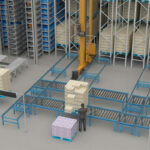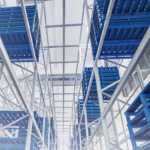Automated sortation systems have become an indispensable part of the supply chain and distribution process. As e-commerce and omnichannel retail have exploded in popularity, the need to quickly and efficiently sort large volumes of diverse packages and parcels has grown exponentially. Modern sortation systems utilise a combination of technologies like scanning, weighing, routing, and conveyance to streamline the sorting process.
The Origins of Automated Sortation
While the earliest known mail sorting systems date back to the 1600s, automated sortation really began to take off in the 1950s. Early systems utilised punch cards and rudimentary computer systems to sort letters and flats. Over the next few decades, technology continued to advance, and by the 1970s, many postal services had implemented systems using OCR and barcoding to automate mail sorting.
The rise of overnight delivery services like FedEx and UPS in the 1970s and 1980s ushered in a new wave of innovation. Faced with rapidly growing volumes of time-sensitive packages, these companies developed the first modern parcel sorting systems using automated routing and conveyor systems. This laid the foundation for the automated sortation systems utilised by major carriers today.
Key Components of Modern Parcel Sortation Systems
Modern parcel sortation systems incorporate an array of technologies to achieve high-speed, high-accuracy sorting.
- Scanning and Dimensioning – Parcels are indexed with 1D or 2D barcodes and then scanned to capture vital information. Scanning also determines the dimensions, weight, and shape of each parcel.
- Routing – Using the captured data, specialised software determines the optimal sort destination and route for each parcel based on factors like service commitments, capacity, etc.
- Conveyance – Parcels are transported via conveyor belt, tilt-tray, or cross-belt systems to their assigned sort location. Vision systems, optical sensors, and mechanical switches guide sorting.
- Sorting – At their destination point, parcels are sorted via technologies like pop-up divert wheels, scanning arms, or pusher/divert arms. Sorted parcels are containerised or staged for dispatch.
- Monitoring – PLCs, sensors, and software track key metrics like throughput, jams, rejects, etc., enabling real-time performance monitoring and optimisation.
Key Benefits of Automated Parcel Sortation
Automated sortation delivers significant benefits across the supply chain:
- High Throughput – Modern systems can process well over 10,000 parcels per hour, far exceeding manual sortation. This enables carriers to handle growing volumes and meet tight service commitments.
- Flexibility – Systems can handle a wide variety of parcel shapes, sizes and weights simultaneously. Some can even sort items together that would normally be processed separately.
- Accuracy – Barcode scanning, vision systems, and sensors enable sortation accuracy exceeding 99%. This minimises costly missorts and delays.
- Speed – Automation enables much faster cycle times and throughput. Carriers can meet same-day and next-day delivery commitments cost-effectively.
- Scalability – Modular systems can scale up or down to match seasonal peaks and changing demands. Additional scanners, conveyors, chutes, etc. can be added as needed.
- Reduced Labor Costs – Automation significantly reduces the need for manual sorting and material handling, yielding major labor cost savings.
Automated sortation has evolved considerably from early punch card systems. Today’s advanced parcel sorters enable carriers and logistics providers to meet the demands of modern commerce and supply chains cost-effectively. With the explosive growth in e-commerce, automated systems will only continue to advance using the latest technologies.
Frequently Asked Questions on Automated Sortation Systems
- What are the main components of modern automated sortation systems?
Modern automated sortation systems incorporate a range of technologies, including barcode scanning, dimensioning, conveyance systems like tilt trays and belt conveyors, divert systems and arms for sorting, and sensors and software for monitoring and control. These components work together to enable high-speed, accurate, automated sorting. - What are some key benefits of automated sortation systems?
Key benefits include much higher throughput and processing speeds compared to manual sortation, ability to handle a wide variety of parcel shapes and sizes, sortation accuracy over 99%, scalability to adjust for changing volumes, and major reductions in labor costs by reducing manual sorting. - What industries commonly utilise automated sortation systems?
Automated sortation systems are most commonly employed by postal services, courier companies, ecommerce fulfillment centres, airports for baggage handling, and distribution warehouses. Their ability to quickly sort large volumes makes them indispensable for many operations. - What are some of the leading suppliers of automated sortation systems?
Some of the top companies providing automated sortation systems and technology include Vanderlande, Siemens Logistics, Beumer Group, Interroll, Intelligrated, Dematic, Bastian Solutions, and Fives Group. They provide complete systems as well as components like scanners, conveyors, and controls. - What recent innovations are changing automated sortation technologies?
Some innovations include predictive analytics to optimise sorting, vision systems and machine learning for more accurate parcel dimensioning and routing, robotics and autonomous mobile robots to reduce manual labor, and more ergonomic and modular sorter designs to facilitate scalability and maintenance. Control systems with detailed performance data enable better visibility and tuning as well.
RELATED: How Automated Sortation Systems Streamline Your Logistics?
Step into the future with SmartlogitecX, a WayZim Technologies venture, reshaping Warehouse Automation in Australia and New Zealand. Our mission is to provide you with advanced, efficient warehouse solutions that are a step ahead. SmartlogitecX combines global tech insights with local market expertise. Ready to upgrade your logistics? Our sales team is on hand to craft your ideal automation strategy.



